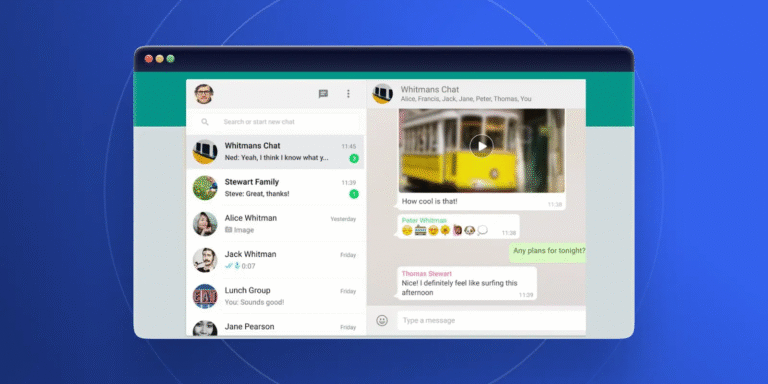There’s an exciting potential in digital education and since the world has shifted towards remote learning, teachers and institutions have had to evolve in order to keep pace. While a dedicated Learning Management System (LMS) like Moodle or Canvas has the theoretical structures of a classroom, it’s often not as immediate and familiar as the learning environments students use each day.
That’s where communication companies like WhatsApp (thanks to its impressive Page feature) and the rich variety of Telegram Chinese channels give you powerful alternative tools that can bridge the gap between the formal curriculum and an accessible and engaging learning experience.
The Ubiquitous Classroom: WhatsApp Page in Action
WhatsApp Page for e-learningIt means that in an e-learning scenario an educational institution, a specific department, or even just one instructor can create a WhatsApp Page so that it can be used as a notice board. The page can be the first point of contact for students where they can find important announcements, schedule updates, links to live lectures and really important resources.
The advantage of such a WhatsApp Page for e-learning is that it is simple and also widely available. As most students already use the service of WhatsApp, all they need to do is follow the WhatsApp Page without having to be taught a new application or remember another password.
Plus, updates are often added. These announcements can also be shared with other classmates or teachers. In fact, according to another academic study of WhatsApp Page. students will create new communities of learning via the group chat for collaborating, asking questions, talking about topics, and advancing skills.
Group messaging can also provide faster responses than a discussion in a formal forum. As a language educator, I have noticed the use of voice notes in a WhatsApp Page (or in an associated group) to practice pronunciation and to teach a term or lesson. When a student is on video, using the share-screen feature of an image provided during the video call can also be used to form ‘mini-tutorials’.
The Content Powerhouse: Leveraging Telegram Chinese Channels
While WhatsApp is the best way to communicate directly on a device, Telegram, in particular via the model of Telegram Chinese knowledge-sharing channels, comes with a different set of benefits for e-learning. The term “telegram Chinese” is a more general term for the large number of channels within the Chinese-speaking community that are sharing all sorts of stuff from news to educational material. It works great for e-learning: an educator can launch one of their own channels (like a Telegram Chinese news channel) and broadcast learning materials directly to subscribers.
The biggest advantage there is the way it handles really rich media and large files. Unlike other messaging apps, Telegram allows users to send files up to 2GB in size. This means a teacher will be able to send full-length video lectures, high-resolution PDF textbooks, highly complex software or datasets over their channel and you can even use the channel as a dedicated, searchable archive for students. This added functionality is based on the resource-heavy channels on Telegram China, and it’s more useful when you want to send lots of heavy learning content that would take up too much space on a WhatsApp Page.
A Synergistic Approach: Combining Both Platforms
The most reliable e-learning strategies tend to be a combination of both the platforms and harness their strengths. An institution may run its official WhatsApp Page for notifications regarding emergency matters, reminders for assignment deadlines and instantaneous Q&A sessions among students. The WhatsApp Page acts as the heartbeat of the class, providing constant synch and real-time engagement.
Likewise, the course instructor can also run a dedicated Telegram channel (e. g. copying the vast collection of content hubs on Telegram Chinese) as the primary source for digital collection of the course. All lecture slides, recorded videos, article for the supplementary reading, and links of software is posted to the Telegram channel. Students are first referred from the WhatsApp Page to the Telegram channel, to access these resources. This separation of work (Whatsapp page) and sharing work (Telegram channel) helps to keep both spaces clear of information overload that can overwhelm students, as well as keeping students organized.
Enhanced Engagement and Accessibility
Both services have relatively low barriers to entry when it comes to e-learning. The familiarity of a WhatsApp Page, on the other hand, reduces the fear students might find after they’ve got to start using a complex new software.
And for students from regions where access to the internet is relatively limited, the lightweight nature of text messages on a WhatsApp Page means they can stay connected even if they can’t upload videos on their phones. In a similar manner, they can download large files on a Telegram (Chinese-style) channel at their leisure.
Conclusion
When it comes to developing tools for digital education, there are two major sets of tools that can be used in this context: a WhatsApp Page that facilitates community building and spontaneous communication, and a resource -rich Telegram channel based on the Telegram Chinese model.
While they might not replace standard LMS modules, they are excellent complementary tools when they connect the dots to meet learners where they are: with a familiar, flexible and highly accessible environment, these two tools are helping democratise education. Learning continues automatically based on one message and one resource shared by all.


